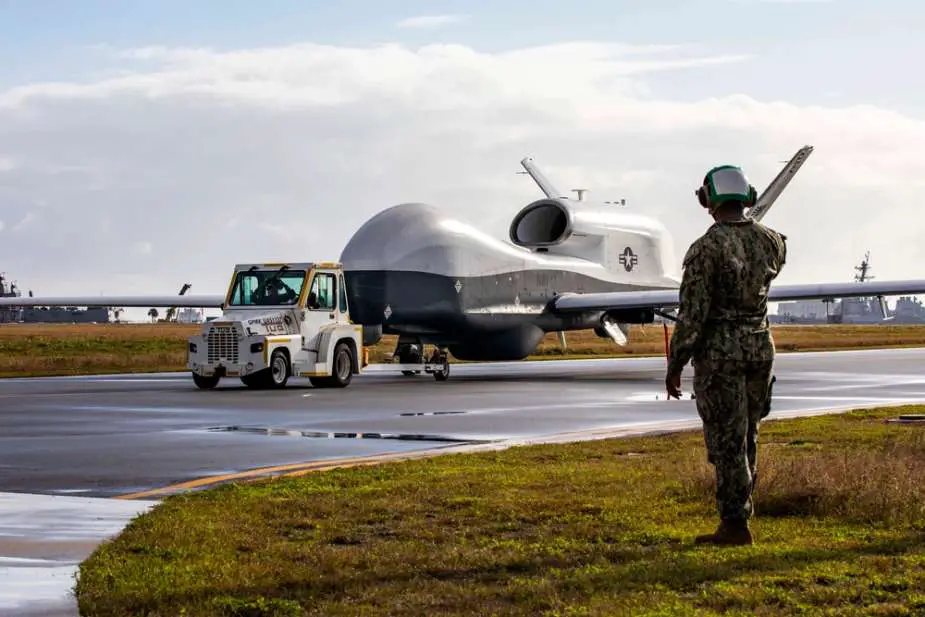Breaking news
Northrop Grumman wins $543 Mn contract for MQ-4C Triton drones.
On October 31, 2023, Northrop Grumman secured a significant contract modification, aimed at facilitating the production and delivery of MQ-4C Triton Unmanned Aircraft Systems (UASs). Under the terms of the agreement, valued at $543 million, the company will manufacture three MQ-4C Triton for the US Navy, and one for Australia, and establish a designated main operating base for the Navy.
Follow Navy Recognition on Google News at this link
 A US Navy's MQ-4C Triton Unmanned Aircraft System (UAS), assigned to Unmanned Patrol Squadron 19 (VUP-19), at Naval Station Mayport, Florida, in 2021. (Picture source: US DoD)
A US Navy's MQ-4C Triton Unmanned Aircraft System (UAS), assigned to Unmanned Patrol Squadron 19 (VUP-19), at Naval Station Mayport, Florida, in 2021. (Picture source: US DoD)
The contract also includes various support services, technical expertise, and administrative data related to these unmanned aircraft. Work on this modification will be carried out at multiple US and international locations, with the following distribution: 80.9% in the United States; 12.1% at various continental US locations (CONUS); 1.1% in Longueil, Quebec, Canada; and 0.5% at various locations outside of the CONUS.
This development is an extension of an $11.5 billion contract previously awarded to Northrop Grumman by the US Navy. That contract is intended to produce 65 advanced MQ-4C Triton UASs equipped with a multi-sensor upgrade, emphasizing Northrop Grumman's role in providing unmanned aircraft solutions for maritime Intelligence, Surveillance, and Reconnaissance (ISR) missions.
The contract modification is scheduled to conclude by January 2028 and will be funded with $411,380,298 from the fiscal year 2023 aircraft procurement (Navy) funds, $971,678 from the fiscal year 2022 aircraft procurement (Navy) funds, and an additional $40 million in cooperative funds from the Royal Australian Air Force. Oversight of this contract falls under the purview of the Naval Air Systems Command, based in Patuxent River, Maryland.
A noteworthy aspect of this development is the collaborative effort between the Royal Australian Air Force (RAAF) and the US Navy, facilitated by the acquisition of an MQ-4C Triton for Australia. This collaboration is intended to enhance data sharing and maintain an autonomous intelligence, surveillance, and reconnaissance (ISR) and targeting capability. The foundation for this cooperation lies in the similar capabilities of the Triton fleets operated by both entities, underscoring their joint commitment to maritime security.
The MQ-4C Triton is a high-altitude, long-endurance unmanned aerial system (UAS) designed for maritime ISR missions. It serves as an addition to the United States Navy's Maritime Patrol and Reconnaissance Force (MPRF) Family of Systems, working alongside the P-8A Poseidon manned aircraft to deliver maritime surveillance capabilities.
The MQ-4C Triton offers features tailored for persistent maritime ISR, including extended mission durations and advanced sensors. The AN/ZPY-3 Multi-Function Active Sensor (MFAS) radar with an active electronically scanned array significantly enhances the system's surveillance capabilities, providing extensive coverage of maritime and coastal areas.
Controlled from ground stations, the MQ-4C Triton features a robust airframe designed to withstand a lengthy 51,000-hour operational life. Safety features, such as the "due regard" radar system, de-icing, and lightning protection systems, ensure safe navigation through cloud layers for closer observations of maritime targets. The open architecture of the mission control system contributes to flexibility and interoperability, while dual redundant flight controls enhance system reliability. The MQ-4C Triton can reach a ceiling of 50,000 feet and has a maximum speed of 331 knots, providing versatility for maritime surveillance.
The MQ-4C Triton originates from the Broad Area Maritime Surveillance (BAMS) program and builds upon the RQ-4 Global Hawk, with modifications to strengthen the airframe and wings. Its sensor suites enable ship tracking, offering critical data on speed, location, and classification.
The MQ-4C Triton achieved its Initial Operational Capability (IOC) in 2018, and reached its initial operating capability with the US Navy in September 2023.























